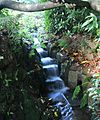Water gardens facts for kids
A water garden is a special kind of garden. Its main focus is water and plants that grow in water. The water can be in a fountain, a pond, a waterfall, or other features. People have been building water gardens for thousands of years.
In hot places like Egypt and Mesopotamia, water gardens were a great way to stay cool. As early as 1225 BC, an Egyptian pharaoh named Ramses III built ponds for water lilies.
The Inca people in Peru also built amazing water features. Around 2500 BC, they made gold and silver water channels, pools, and basins. Their homes and palaces even had water flowing under the floors to cool the air. Their courtyards had cool pools for tired travelers to rest in.
The Chinese and Japanese copied nature in their water gardens. For them, a water garden was a sign of perfection and peace. By the 3rd century AD, they had written down the main ideas for building a water garden. In the 15th century, they made water gardens into an art form. They used the sound and movement of water to create beauty. A still pool that reflected the sky showed the connection between heaven and earth. The Japanese also built "dry gardens." These gardens used small rocks and sand to look like a stream or river. Nature was recreated to help people think and relax.
Europeans started using water for fun in their gardens during the Middle Ages. Springs and wells became important parts of gardens. Carp fish ponds were not just for food. In monasteries, they were also places for quiet thought and rest. In Spain, the serious look of the Alhambra palace was made softer with canals and pools.
Contents
Related pages
Gallery
Images for kids
-
The Vanderbilt Mansion pond
-
Lotus, Nelumbo nucifera
-
Koi fish
-
Hatchet Pond, New Forest, England
See also
 In Spanish: Jardín acuático para niños
In Spanish: Jardín acuático para niños






















